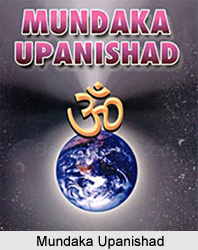 The Mundaka Upanishad is among the older, primary or Mukhya Upanishadas. The Mundaka Upanishad is associated with the Atharva Veda. It is the fifth in the Muktika canon of hundred and eight Upanishads. The Mundaka Upanishad is the Mantra Upanishad. It has three chapters and each chapter is divided into subchapters called `Khanda`. The Mundaka Upanishad has sixty-four Mantras in total.
The Mundaka Upanishad is among the older, primary or Mukhya Upanishadas. The Mundaka Upanishad is associated with the Atharva Veda. It is the fifth in the Muktika canon of hundred and eight Upanishads. The Mundaka Upanishad is the Mantra Upanishad. It has three chapters and each chapter is divided into subchapters called `Khanda`. The Mundaka Upanishad has sixty-four Mantras in total.
1st Chapter of Mundaka Upanishad
The 1st Chapter of Mundaka Upanishad relates about the sciences taught by Lord Barhama to his eldest son Atharva. The chapter has been divided into two khandas and discusses about the real Self.
1st Khanda of 1st Chapter
Lord Brahma, the creator and preserver of the universe was first produced among the gods. He taught the science of Brahman, the foundation of all sciences, to Atharva, his eldest son. He then explained it to Satyavaha of the family of Bharadvaja. The Khanda discusses about the two sciences that relate about the knower of Brahman, the highest and the lowest. The lowest science states about the Rig Veda, the Yajur Veda, the Sama Veda and the Atharva Veda. The highest is the science, by which that indestructible Brahma can be comprehended.
2nd Khanda of 1st Chapter
The works which the wise reveal in the Mantras were of the Treta Yuga. When the fire is kindled the sacrifice must be offered with faith and devotion. The sacrifice must be performed at the right time of the day following all the rules and regulations. Else the sacrificer cannot attain the seven worlds. The seven flickering tongues of the fire are, Kali (the black one), Karali (the terrific one), Manojava (swift the mind), Sulohita (the very red one), Sudhumravarna (of purple colour), Sphulingini (emitting sparks), and the Visvarup (all shaped) goddess. One who understands the real Self gets free form the bonds of birth and death, others who live in the world of ignorance fancying them wise and learned, go round and round, oppressed by misery.
2nd Chapter of Mundaka Upanishad
The 2nd Chapter of Mundaka Upanishad states about the Brahma from whom everything is produced and evolved. He is all pervading and resides within all. The 2nd Chapter of Mundaka Upanishad has been divided into two Khandas.
1st Khanda of 2nd Chapter
As sparks are produced from the fire in thousand ways, the soul is also produced from the indestructible Brahman that takes different forms. It resides within the heart, without origin, without life, without mind, he is pure and greater than the great indestructible one. From this Brahman are produced life, mind, and all the organs, ether, air, light, the water and the earth, the support of all. His head is the fire, eyes are the moon and the sun and ears the quarters. The Rig Veda, Sama Veda, Yajur Veda and Atharva Veda are produced from him. He is thus, the producer of all.
2nd Khanda of 2nd Chapter
Brahma is the great soul from whom is produced all that moves, breathes and closes.
The indestructible Brahma is life, speech and mind. It is true and immortal. The Om Mantra is called the bow, the arrow the soul, and Brahma its aim. The heavens, the earth, the atmosphere, the mind with all the organs are based on him. The immortal Brahma is before, Brahma behind, Brahma to the right and to the left, below and above, all-pervading. One who realises this gets rid from the cycle of birth and death.
3rd Chapter of Mundaka Upanishad
The 3rd Chapter of Mundaka Upanishad discusses about the realisation of the Brahman. It has been divided into two Khandas.
1st Khanda of 3rd Chapter
Two birds, always united, of equal name, dwell upon one and the same tree. Dwelling on the same tree with the supreme soul the individual soul remains immersed in the relations of the world. He remains engaged in the materialistic world. However, when he realises the Supreme Brahman all his grief ceases. The wise men who are aware of the real Self do not speak of anything else. He then remains immersed in the Brahman. The soul can be obtained by the constant practice of truth, of devotion, of perfect knowledge. The Brahman cannot be apprehended by the eye, by speech, by the other senses, by devotion or rites.
2nd Khanda of 3rd Chapter
He who knows this supreme Brahman becomes wise and free from desires. He will not be born again. The soul cannot be gained by knowledge of the Vedas, not by understanding it, not by manifold science. It can be obtained by the soul by which it is desired. His soul reveals its own truth. Whoever knows this supreme Brahman becomes even Brahman. He overcomes grief, sin and he becomes immortal, liberated from all the bonds. One who has understood the meaning of Brahman, whose intellects are purified and has become free from all desires attains the Self and becomes immortal.



















